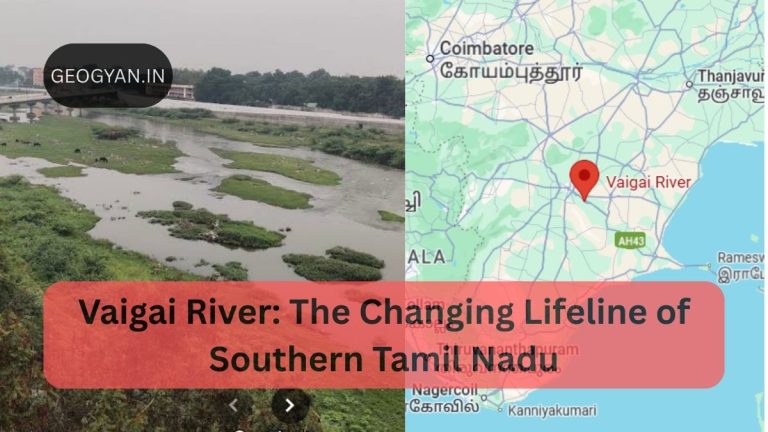Landsat
Many weather satellites help observe the Earth’s surface, but they are not designed for detailed land mapping. In the 1960s, images from weather satellites and manned space missions showed the potential of space-based Earth monitoring. Inspired by this, NASA launched Landsat-1 in 1972, initially called ERTS-1 (Earth Resources Technology Satellite). It was an experiment to see if an unmanned satellite could collect multi-spectral images of the Earth’s surface. Earth Observation Satellites have since become vital in capturing detailed images of our planet.
Since then, the Landsat program has become one of the most successful Earth observation programs, gathering data from multiple satellites over the years. NASA originally managed Landsat, but in 1983, control was given to NOAA (National Oceanic and Atmospheric Administration). In 1985, the program became commercialized, making its data available for public and research use.
Why is Landsat Important?
Landsat has been successful because of several key features:
- Specialized Sensors: Landsat carries instruments designed to observe different aspects of the Earth’s surface.
- Good Spatial Resolution: It captures images at a resolution suitable for studying land features.
- Large Coverage: It covers wide areas and revisits locations frequently.
- Long-term Data Collection: Since Landsat has been operating for decades, it provides valuable historical data to track environmental changes over time.
Landsat Orbits and Revisit Time
All Landsat satellites follow a near-polar, sun-synchronous orbit, meaning they pass over the same location at the same time of day to maintain consistent lighting conditions.
- Landsat 1-3: Orbit at 900 km altitude, revisiting the same area every 18 days.
- Landsat 4 and later: Orbit at 700 km altitude, with a 16-day revisit period.
Landsat Sensors
Over the years, Landsat satellites have carried different types of sensors, including:
- Return Beam Vidicon (RBV) Camera
- MultiSpectral Scanner (MSS)
- Thematic Mapper (TM)
The MSS and TM sensors were the most widely used. Each of these sensors captured images over a 185 km-wide area, with a full scene covering 185 km × 185 km.
MultiSpectral Scanner (MSS)
- Captures images in four spectral bands (different parts of the light spectrum).
- Spatial resolution: 60 × 80 meters (each pixel represents this area on the ground).
- Uses an oscillating mirror to scan the Earth’s surface.
- Records six scan lines at a time as the satellite moves.
This data helps scientists monitor deforestation, urban growth, agriculture, water bodies, and climate changes over time.
The routine collection of MSS (Multispectral Scanner) data stopped in 1992 because the TM (Thematic Mapper) sensor, introduced with Landsat 4, provided better data. TM offers several improvements over MSS, such as:
- Higher spatial and radiometric resolution
- More precise spectral bands (seven instead of four)
- More detectors per band (16 for non-thermal channels compared to six in MSS)
TM captures 16 scan lines at once for non-thermal bands and four for the thermal band. It uses an oscillating mirror that scans both forward (west to east) and backward (east to west). This scanning method increases the time each pixel is observed, improving the accuracy and quality of the data.
The spatial resolution of TM is 30 meters for most bands, except for the thermal infrared band, which has a 120-meter resolution. TM data is recorded in 8-bit format, meaning each pixel has a digital value between 0 and 255.
MSS Bands
| Landsat 1,2,3 | Landsat 4,5 | Wavelength Range (μm) | Band Type |
| MSS 4 | MSS 1 | 0.5 – 0.6 | Green |
| MSS 5 | MSS 2 | 0.6 – 0.7 | Red |
| MSS 6 | MSS 3 | 0.7 – 0.8 | Near Infrared |
| MSS 7 | MSS 4 | 0.8 – 1.1 | Near Infrared |
Both TM and MSS data are useful for many applications, such as:
- Resource management (e.g., tracking water and land use)
- Mapping (creating accurate land maps)
- Environmental monitoring (observing climate and ecosystem changes)
- Change detection (monitoring deforestation, urban growth, etc.)
Canada has a large collection of satellite images, including over 350,000 MSS scenes and over 200,000 TM scenes, managed by RSI Inc., the official distributor. Many more images are stored in different countries worldwide.

TM Bands
| Channel | Wavelength Range (μm) | Application |
| TM 1 | 0.45 – 0.52 (blue) | Soil/vegetation discrimination; bathymetry/coastal mapping; cultural/urban feature identification |
| TM 2 | 0.52 – 0.60 (green) | Green vegetation mapping (measures reflectance peak); cultural/urban feature identification |
| TM 3 | 0.63 – 0.69 (red) | Vegetated vs. non-vegetated and plant species discrimination (plant chlorophyll absorption); cultural/urban feature identification |
| TM 4 | 0.76 – 0.90 (near IR) | Identification of plant/vegetation types, health, and biomass content; water body delineation; soil moisture assessment |
| TM 5 | 1.55 – 1.75 (shortwave IR) | Sensitive to moisture in soil and vegetation; discriminating snow and cloud-covered areas |
| TM 6 | 10.4 – 12.5 (thermal IR) | Vegetation stress and soil moisture discrimination related to thermal radiation; thermal mapping (urban, water) |
| TM 7 | 2.08 – 2.35 (shortwave IR) | Discrimination of mineral and rock types; sensitive to vegetation moisture content |
SPOT (Satellite for Earth Observation)
SPOT (Système Pour l’Observation de la Terre) is a series of Earth observation satellites developed by France’s space agency (CNES), with support from Sweden and Belgium. The first satellite, SPOT-1, was launched in 1986, and new satellites followed every 3-4 years.
These satellites orbit the Earth at about 830 km in a sun-synchronous, near-polar orbit. This means they pass over the same area every 26 days at around 10:30 AM local solar time. SPOT was designed for commercial use and was the first satellite to use “pushbroom scanning technology” for capturing images.
Imaging System and Capabilities
Each SPOT satellite has two high-resolution imaging systems, called HRV (High-Resolution Visible). These cameras can work independently or together. The HRV sensors can operate in two modes:
- Panchromatic (PLA) Mode – Captures black and white images with a high resolution of 10 meters.
- Multispectral (MLA) Mode – Captures color images in three bands (Red, Green, Infrared) with a lower resolution of 20 meters.
The sensors can view areas up to 60 km wide when looking straight down (nadir). They can also tilt up to 27° to the side, allowing them to cover a wider area (up to 950 km) and revisit the same place multiple times in a week. This tilting capability helps capture stereoscopic (3D) images, which are useful for mapping and terrain studies.

Benefits and Applications
SPOT has several advantages over other satellite imaging systems:
- High resolution for detailed mapping (urban planning, agriculture, forestry).
- Multispectral imaging for better land cover classification and analysis.
- Ability to tilt sensors for frequent monitoring and 3D terrain modeling.
- Cloud-free imaging by adjusting angles to avoid cloud cover.
SPOT data is widely used for applications like agriculture, forestry, land use planning, and creating Digital Elevation Models (DEMs) for mapping and navigation. It provides cost-effective and timely satellite data for various scientific and commercial uses.
HRV Mode Spectral Ranges
| Mode/Band | Wavelength Range (μm) |
| Panchromatic (PLA) | 0.51 – 0.73 (blue-green-red) |
| Multispectral (MLA) |
| Band 1 | 0.50 – 0.59 (green) |
| Band 2 | 0.61 – 0.68 (red) |
| Band 3 | 0.79 – 0.89 (near infrared) |
Indian Remote Sensing (IRS) Satellites
The Indian Remote Sensing (IRS) satellite series is designed to collect images of Earth’s surface. It includes features from both the Landsat and SPOT satellites, which are well-known for capturing satellite images.
One important satellite in this series, IRS-1C, was launched in December 1995. It has three main sensors:
- Panchromatic (PAN) Camera – A high-resolution sensor that captures black-and-white images. It can be tilted up to 26°, allowing for 3D (stereoscopic) images and frequent revisits (every 5 days). This is useful for urban planning and mapping.
- LISS-III (Linear Imaging Self-Scanning Sensor) – A medium-resolution sensor with four multispectral bands, similar to Landsat’s TM bands. It helps in vegetation study, land-cover mapping, and resource management.
- WiFS (Wide Field Sensor) – A low-resolution sensor with two spectral bands, similar to NOAA’s AVHRR sensor. It is useful for large-scale vegetation monitoring.
Each of these sensors plays an important role in studying Earth’s surface, helping in agriculture, forestry, urban development, and environmental management.
IRS Sensors
| Sensor | Wavelength Range (μm) | Spatial Resolution | Swath Width | Revisit Period (at Equator) |
| PAN | 0.5 – 0.75 | 5.8 m | 70 km | 24 days |
| LISS-II Green | 0.52 – 0.59 | 23 m | 142 km | 24 days |
| LISS-II Red | 0.62 – 0.68 | 23 m | 142 km | 24 days |
| LISS-II Near IR | 0.77 – 0.86 | 23 m | 142 km | 24 days |
| LISS-II Shortwave IR | 1.55 – 1.70 | 70 m | 148 km | 24 days |
| WiFS Red | 0.62 – 0.68 | 188 m | 774 km | 5 days |
| WiFS Near IR | 0.77 – 0.86 | 188 m | 774 km | 5 days |
MEIS-II and CASI: Canadian Airborne Sensors
While this post focuses on satellite sensors, it is important to mention two Canadian airborne sensors—MEIS-II and CASI. These sensors have played a key role in remote sensing and have influenced the design of satellite systems.
MEIS-II (Multispectral Electro-optical Imaging Scanner)
MEIS-II was developed by the Canada Centre for Remote Sensing. Although it is no longer in use, it was the first airborne sensor to use pushbroom scanning technology, which scans along the direction of flight.
- It captured images in eight spectral bands, covering wavelengths from 0.39 to 1.1 μm.
- The sensor had 1728 detectors per band and provided 8-bit data (256 digital values per pixel).
- Users could select different wavelength ranges based on their application needs.
- It also had stereo imaging capability, meaning it could capture images from different angles in a single flight.
MEIS-II contributed to the development of advanced satellite and airborne remote sensing systems by allowing flexible imaging options and stereo mapping.
CASI (Compact Airborne Spectrographic Imager)
CASI is an advanced airborne sensor and was the first commercial hyperspectral imaging spectrometer. Unlike MEIS-II, which captured images in a few spectral bands, CASI detects a large number of narrow bands across the visible and infrared spectrum.
- It covers a spectral range of 0.4 to 0.9 μm, divided into 288 narrow bands (each 0.018 μm wide).
- The spatial resolution depends on the altitude of the aircraft.
- Users can adjust the spectral bands and bandwidths according to their needs.
- CASI helps in analyzing the absorption and reflection properties of objects, creating a spectral fingerprint for different materials.
Experiments with CASI and similar hyperspectral sensors have helped in designing advanced satellite sensors for detailed remote sensing applications.





























